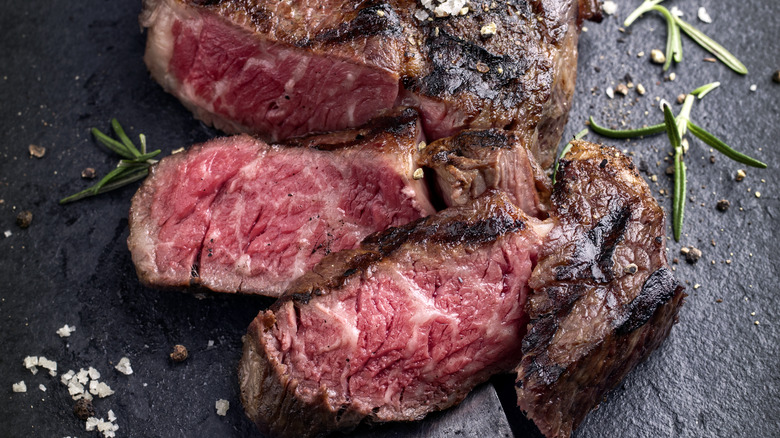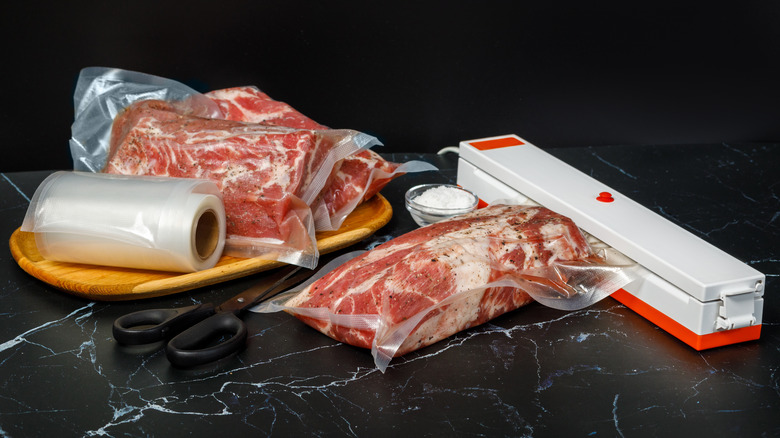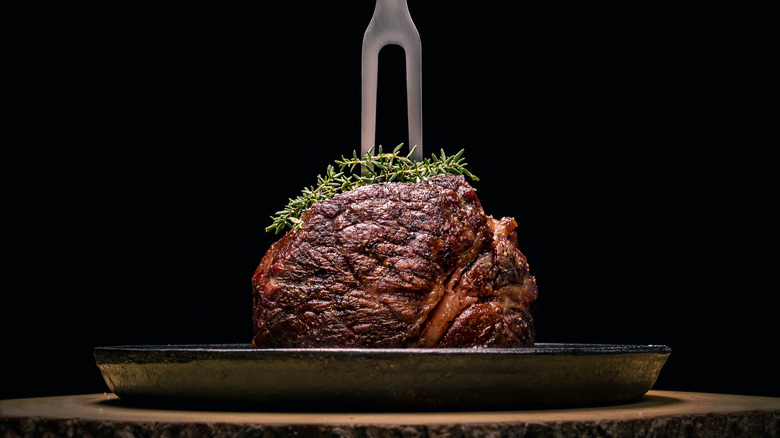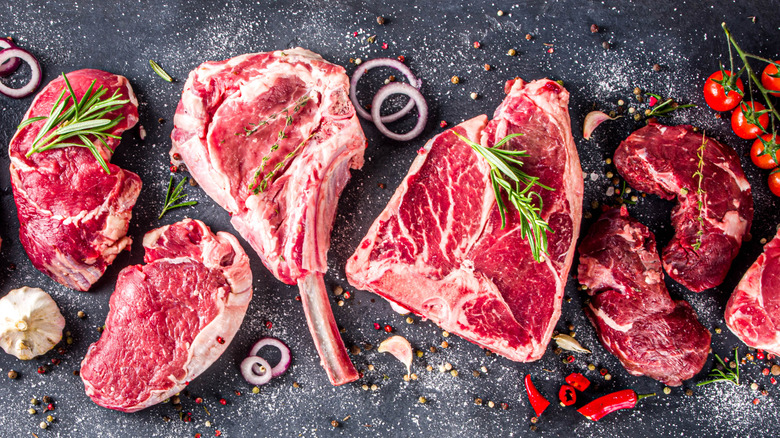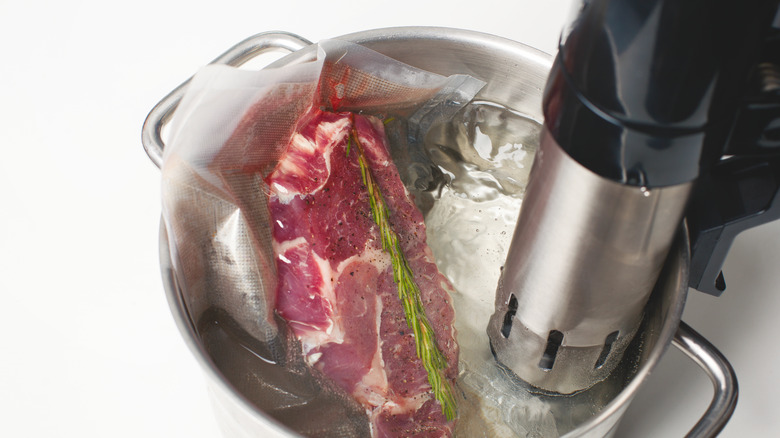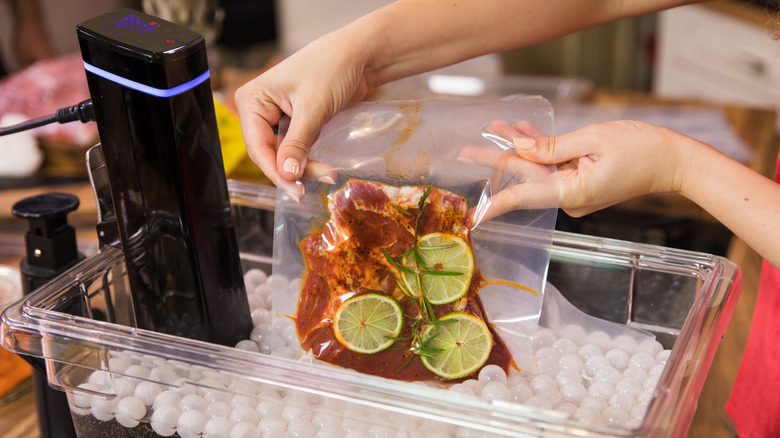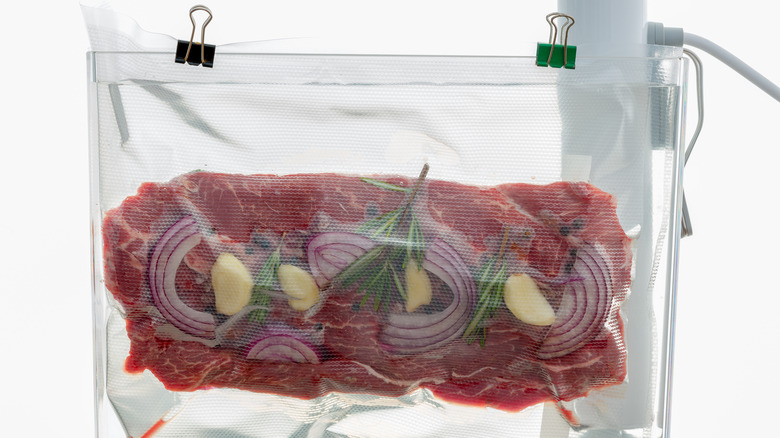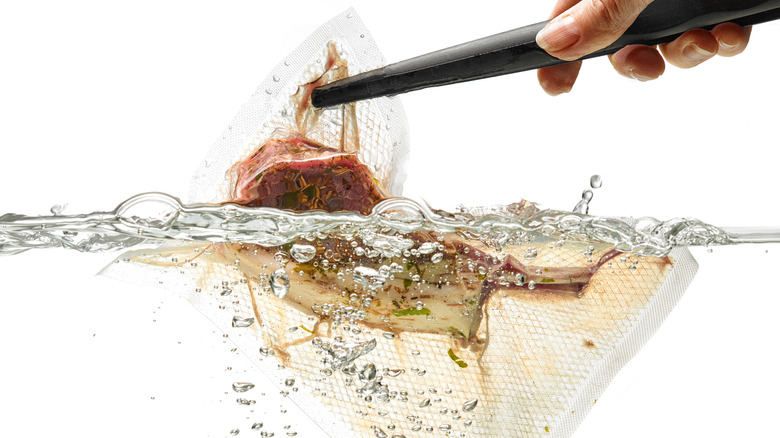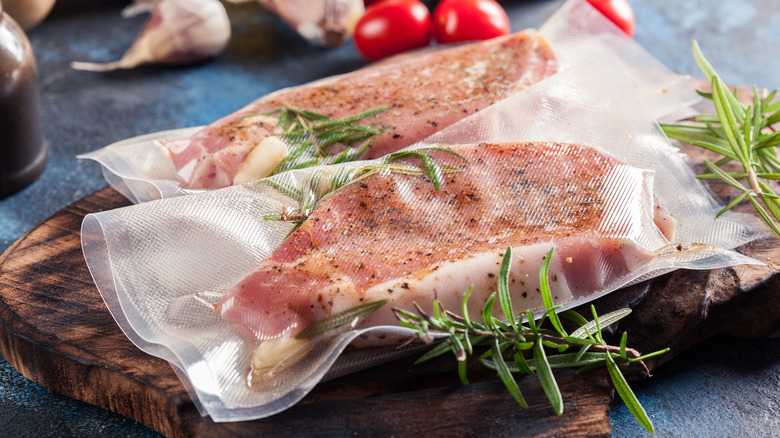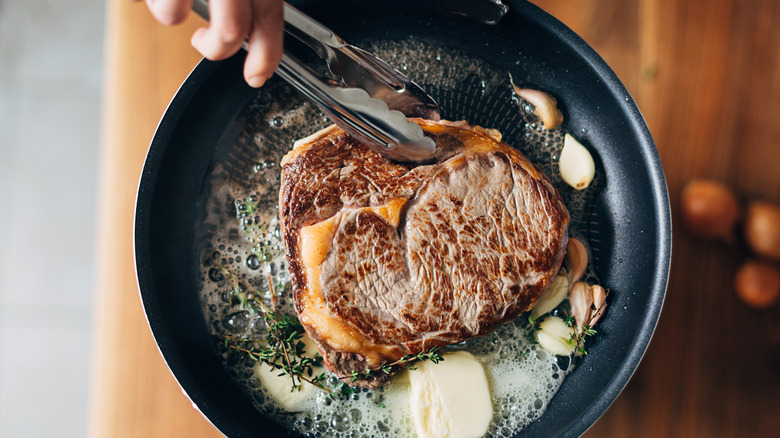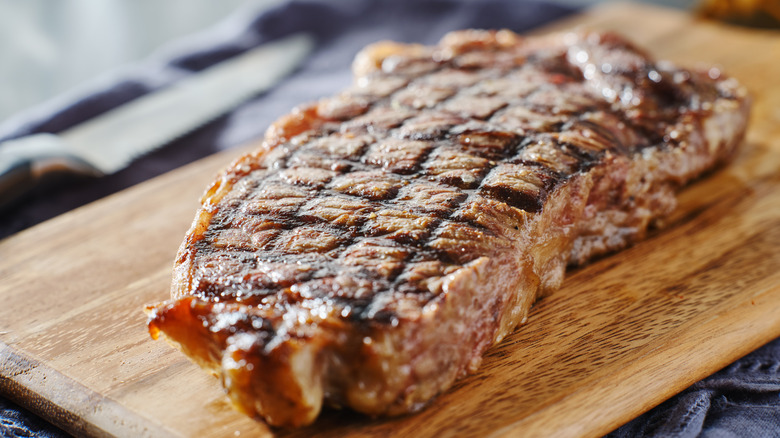Everything You Need To Know About Sous Vide Steak
We may receive a commission on purchases made from links.
There is a primal attraction to the experience of a slab of meat cooking over live coals on a backyard grill. It connects us to the past: our youth, dad and mom in the backyard, and maybe even a caveman or two. However, it's worth considering cooking your next steak with the sous vide method.
Sometimes the Law of Unintended Consequences comes into play. Romance must occasionally make way for reality — and reality, at backyard barbecues, sometimes arrives in the form of overcooked meat. In contrast, pretty much nothing ever comes out of a sous vide water bath overdone (for the most part). Sous vide steak for the win.
And the process is exceptionally easy. One could be forgiven for believing the method was invented for cooking steaks. It's a matter of setting it, getting it, searing it, resting it, and it's perfect. Read on for a primer on foolproof sous vide steak cooking.
What is sous vide?
Sous vide is a method of cooking in which food, particularly (but not exclusively) proteins like meat and fish, is vacuum-sealed in a food-grade plastic bag and cooked to a precise temperature in a water bath.
While this process may be most widely known as a technique employed by high-end, fine dining chefs, that is not how it began. According to NPR, the sous vide originated from the desire to make hospital food taste better. The technique revolutionized food preparation in institutions and quickly became popular among commercial food companies. Before long, chefs like George Pralus and Pierre Troisgros were also using the cooking method (via Cook's Illustrated).
Thomas Keller was one of the first American chefs to use the technique at his early restaurant, Rakel, in the late 1980s, as he explained in an interview with Sous-Vide Magazine. Today, it is ubiquitous in high-end restaurants the world over. And it has begun to achieve acceptance in domestic homes, too, per The Washington Post.
Benefits of preparing sous vide steak
The main advantage of preparing sous vide steak is precision: you can control the cooking temperature of the meat throughout the entire process. This leads to greater consistency in how the steak is cooked as well as its taste (per Anova).
The technique is also relatively safe, and Amazing Food Made Easy hints, the level of safety in sous vide food preparation is not much different from conventional cooking. Steak held too long inside the so-called "danger zone" presents a risk of foodborne illness due to bacteria growth in the anaerobic environment inside the sous vide bag. However, as PolyScience points out, proper food handling mitigates this risk. If you properly seal the steak's bag, cook it long enough, avoid the mistake of not fully submerging it in the water bath, and remove the meat from the water once the cooking time has elapsed, it will be safe.
Types of steak used for sous vide
In theory, you can cook any steak using the sous vide method. For example, you could prepare a skirt steak –- a long, thin cut from the plate section –- but it's not often recommended. The sous vide technique might yield a tender skirt steak, but it would be nearly impossible to get it tender and then sear it without overcooking the meat. On the other hand, if you sous vide a thicker steak, it will have the same level of doneness throughout when you finally remove it from the vacuum-sealed bag. The internal temperature of the meat will be uniform because not one part of the meat will be any hotter than the temperature of the water you set.
So, sous vide cooking works better with larger steaks. According to Anova, you should use a cut at least 1 ½ to 2 inches thick. That way, once it comes out of the bag, you can dry the surface and sear it without overcooking.
When picking the type of cut ideal for sous vide cooking, ribeye and strip steaks are particularly good choices, as well as porterhouse or T-bone. Beyond that, look for the same basic characteristic you should normally look for in raw steak: great marbling.
Tools needed to sous vide steak
So it is time to get started on your own sous vide journey. To do so, you will need two essential pieces of equipment: an immersion circulator (aka "sous vide machine") and a vacuum sealer. While immersion circulators were once large pieces of equipment taking up valuable kitchen real estate, they are now more compact; two of the most popular brands are Anova and Joule. The gold standard for vacuum sealers is probably the FoodSaver V4400, but it is both bulky and pricey. For less than half the tab, Anova's ANVS01-US00 will get the job done and take up less space in the kitchen.
There are certainly other brands and models of immersion circulators and vacuum sealers out there, but these options will get you well on your way to the perfect sous vide steak. You will also need a water bath container, but there is no reason that a large soup pot won't work.
How to sous vide steak
Cooking steak with the sous vide method only requires a few easy steps. First, defrost the meat and fill your chosen vessel with water. Attach the immersion circulator and set the temperature corresponding to your desired doneness. Next, pat dry and season the steaks, then add them to a food-safe bag with your choice of herbs, aromatics, or butter. Seal the bag (either with a vacuum-sealer or the displacement method) and fully submerge it in the water bath. Make sure that the top of the bag is securely clipped to the edge of the container.
After the steak has cooked all the way through, remove it from the bag, pat dry, then sear each side with additional ingredients (as desired) in a hot skillet. Finally, briefly rest the meat before serving. We recommend pairing the steak with your favorite roasted vegetables, such as carrots or asparagus, or mashed potatoes.
Vacuum-sealing sous vide steak
Is a vacuum sealer really important if you want to use the sous vide method? The short answer is: sort of. As ChefSteps points out, a good seal on the steak is necessary, and a vacuum sealer is the easiest and best way to achieve that. However, using this kitchen tool is not required.
Although vacuum sealers may be the optimal way to seal a bag for sous vide cooking, it can be done using the water displacement method. Just put the steak in a resealable bag (think Ziploc) you probably already have in your kitchen and lower it into a tub of water (like the one you are about to cook the steak in). As Anova explains: "the pressure of the water forces the air through the top of the bag. Once most of the air is out of the bag, carefully seal it just above the water line."
Adding ingredients to sous vide steak to increase flavor
The secret to great steak for many cooks is adding aromatics. Often, chefs baste the meat with butter as they prepare it with aromatics and herbs throughout the process. The result is that these flavors elevate the steak as it's cooked, resulting in an unforgettable meal.
And, as Amazing Food Made Easy points out, what works so well in the pan also works in the sous vide bag. Herbs (like thyme and rosemary), aromatics (like ginger, garlic, and onion), citrus (like orange, lemon, or lime), as well as butter and other fats, are natural accompaniments to steak. You can also combine the butter and herbs to make a compound butter.
Adding these ingredients to the same bag as the steak means the flavor of the fats, herbs, citrus, or aromatics infuse into the meat as it cooks. However, alternatively, you can add them during the searing step.
Cooking temperatures for sous vide steak
Everyone loves diving into a steak with that perfect char on the outside and tender juiciness on the inside. But it doesn't always come out that way. Pretty much everyone can relate to the disappointment of an overdone steak: A true mistake if not an outright tragedy. Sous vide, however, can go a long way to making that sort of thing a relic of the past. Because the temperature in a sous vide water bath never exceeds the target internal temperature of the finished steak, it is nearly impossible to overcook it.
There are several considerations with sous vide cooking temperatures: Flavor, texture, the thickness of the meat, and food safety are the prime ones. In general, your sous vide temperatures will vary according to your desired level of doneness. Anything below 129 F will result in rare steak, while 129 F to 134 F will yield medium-rare meat. According to Anova, the temperature to achieve a medium-cooked steak should be 135 F to 144 F.
While some consider a steak beyond rare to be overdone, the USDA is not amongst them. The agency classifies anything cooked to an internal temperature below 140 F to be in the "danger zone." Others insist that the sous vide method offers a level of accuracy and control that increases safety at temperatures that would be dangerous with other methods — supposedly making it safe at temperatures above 130 F (via Anova).
Cooking times for sous vide steak
The other major factor to remember when preparing a steak using the sous vide method is cooking time. Too short a duration and you risk undercooking the meat. On the other hand, while the chances of you overcooking a steak are fairly low with this technique, the longer it's in the bath, the more the final texture will be affected. With that said, for a 1-inch cut of steak, 70 minutes is just about right (via Amazing Food Made Easy). For a 1 ½ inch cut, cook the meat for 2 ½ hours.
Additionally, Amazing Food Made Easy explains that the risk of overcooking also comes from searing the steak too long after it emerges from the water bath. Because the meat is already cooked, searing it anywhere close to as long as one would using conventional techniques is likely to hammer them. Sear sous vide steaks for no more than 45 to 90 seconds per side.
Searing sous vide steak
A critical step in cooking sous vide steak comes after the meat is removed from the water bath: searing. This is important for cosmetic, flavor, and textural reasons (via Sous Vide). Additionally, because the steak is cooked evenly throughout and to a precise temperature, it won't have the char you want. For that, you need to add a sear.
There are multiple ways to sear sous vide steak (including the use of a torch, which is fun but adds an "off" odor), but the easiest and fastest method is on your stovetop in a cast-iron skillet (per Anova) or another heavy, steel pan.
The first step is to thoroughly dry the surface of the steak (some recommend that you chill the meat after removing it from the water bath and before drying). Next, get your pan extremely hot, then carefully lay the steak inside. At this stage, you can add a pat of butter, herbs like rosemary or thyme, or other aromatics of your choice — especially if you hadn't added these ingredients in the sous vide bag. Flip the steak to get both sides seared, and do not forget to sear the sides as well (tongs are essential for this).
Resting sous vide steak
When cooking a steak (or some other proteins) by traditional, non-sous vide methods, one essential step is setting the meat aside to rest for five to ten minutes before cutting and serving. Whether or not a seared sous vide steak needs to be rested similarly is a matter of debate. Some sources, like Anova, say that the temperature gradient from the sear is not great enough to make this step necessary. But others, like Amazing Food Made Easy, disagree, saying that this allows for the reabsorption of the meat's juices for a more flavorful finish.
However, generally speaking, there is little reason not to rest the steak other than the primal desire to get into that delicious little slab of protein goodness as soon as possible. With that said, we recommend that you resist that urge for at least five minutes — then have at it. It'll all be worth it.
